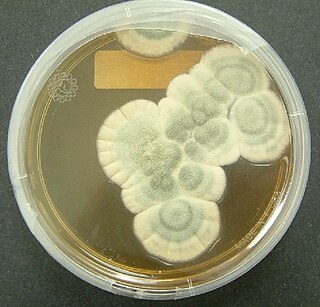
Penicillium is a genus of ascomycetous fungi that is part of the mycobiome of many species and is of major importance in the natural environment, in food spoilage, and in food and drug production.

Cicer is a genus of the legume family, Fabaceae, and the only genus found in tribe Cicereae. It is included within the IRLC, and its native distribution is across the Middle East and Asia. Its best-known and only domesticated member is Cicer arietinum, the chickpea.

Penicillium roqueforti is a common saprotrophic fungus in the genus Penicillium. Widespread in nature, it can be isolated from soil, decaying organic matter, and plants.

Penicillium chrysogenum is a species of fungus in the genus Penicillium. It is common in temperate and subtropical regions and can be found on salted food products, but it is mostly found in indoor environments, especially in damp or water-damaged buildings. It has been recognised as a species complex that includes P. notatum, P. meleagrinum, and P. cyaneofulvum. Molecular phylogeny has established that Alexander Fleming's first discovered penicillin producing strain is of a distinct species, P. rubens, and not of P. notatum. It has rarely been reported as a cause of human disease. It is the source of several β-lactam antibiotics, most significantly penicillin. Other secondary metabolites of P. chrysogenum include roquefortine C, meleagrin, chrysogine, 6-MSA YWA1/melanin, andrastatin A, fungisporin, secalonic acids, sorbicillin, and PR-toxin.
Penicillium austroafricanum is a fungus species of the genus of Penicillium
Penicillium alfredii is a fungus species of the genus of Penicillium which is named after Alfred P. Sloan.
Penicillium clavistipitatum is a fungus species of the genus of Penicillium.
Penicillium confertum is an anamorph fungus species of the genus of Penicillium.
Penicillium contaminatum is a fungus species of the genus of Penicillium.
Penicillium coralligerum is a species of the genus of Penicillium. It is a marine species sometimes referred to as a deep-sea fungus and in some languages named the equivalent of "deep-sea mold".
Penicillium cryptum is a species of the genus of Penicillium.
Penicillium crystallinum is a species of the genus of Penicillium.
Penicillium dierckxii is a species of the genus of Penicillium which produces citreoviridin and citrinin.
Penicillium dodgei is a species of the genus of Penicillium.
Penicillium dunedinense is a species of the genus of Penicillium which was isolated in Dunedin in New Zealand.
Penicillium ellipsoideosporum is a species of the genus of Penicillium which was isolated in China.
Penicillium flavidostipitatum is a species of the genus of Penicillium which produces patulin.
Penicillium hetheringtonii is a species of the genus of Penicillium which is named after A.C. Hetherington. This species was first isolated from beach soil in Land's End Garden in Treasure Island, Florida in the United States. Penicillium hetheringtonii produces citrinin and quinolactacin.
Penicillium paradoxum is a species of fungus in the genus Penicillium. Penicillium paradoxum grows on dog dung and is phototropic, and has a characteristic odour. Unusual for Penicillium, the fungus has an Aspergillus-like conidial head, not a penicillus.



